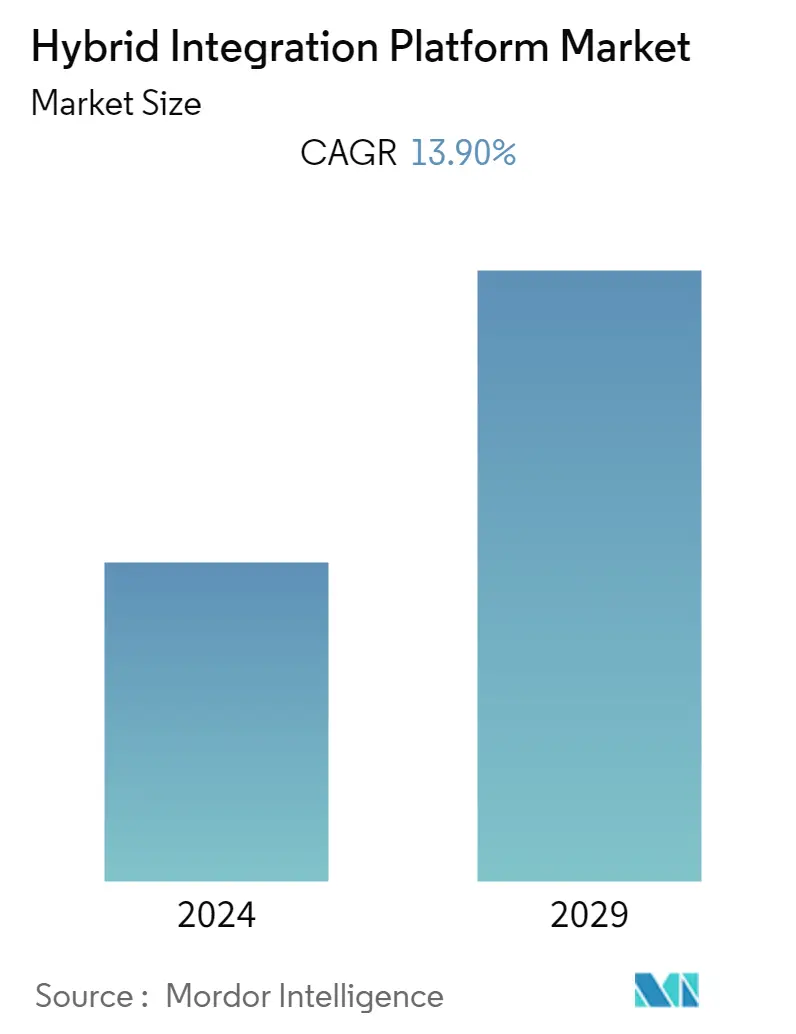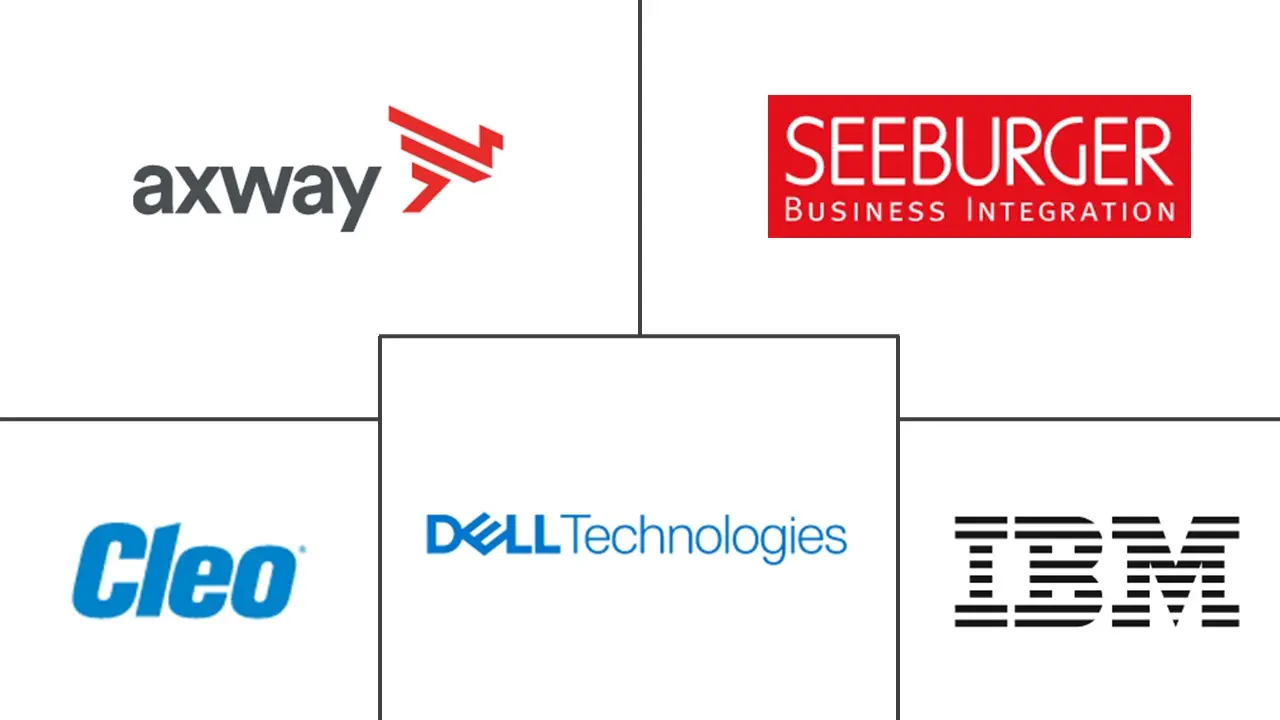Market Size of Hybrid Integration Platform Industry

| Study Period | 2019 - 2029 |
| Base Year For Estimation | 2023 |
| CAGR | 13.90 % |
| Fastest Growing Market | Asia-Pacific |
| Largest Market | North America |
| Market Concentration | Low |
Major Players
*Disclaimer: Major Players sorted in no particular order |
Hybrid Integration Platform Market Analysis
The hybrid integration platform market is expected to register a CAGR of 13.9 percent during the forecast period. Hybrid integration platforms drive digital transformation in industries. The mere deployment of the cloud in operations cannot make businesses fully leverage it to optimize their operations. One of the major roadblocks that frequently comes up in cloud adoption is the integration of cloud and on-premise applications. Because of this, organizations need help with problems like latency in their operations, which leads to missed deadlines, dissatisfied customers, and many more unresolved issues. A hybrid integration platform ensures the seamless integration of various business applications and a secure gateway for data transactions across different hosting environments.
- The demand for hybrid cloud in recent years has gained traction, as has the need for hybrid integration platforms for its successful deployment. The cost savings and scalability achieved by the successful deployment of hybrid clouds have increased the competencies of organizations across industries. So, the other companies in the industry also plan to use this to expand the use of the technology.
- Hybrid integration platforms connect the network between enterprises, customers, and suppliers via BYOD (enterprise mobile) and big data, allowing on-premises applications to integrate with cloud-based applications. As a result, hybrid integration platform adoption is increasing. Another important element driving demand for hybrid integration platforms is the growing need for cloud-based apps, data, and services.
- The increasing deployment of cloud-based solutions across various sectors to maximize industrial digitalization is a significant driving factor for the growth of the industrial hybrid integration platform market throughout the forecast period. Various governments throughout the globe are investing heavily in digitalization to improve job efficiency and flexibility. Many companies are concerned about interoperability across different cloud environments and data security. This security need drives the demand for hybrid integration platforms.
- However, the high risks associated with open-source integration and interoperability are considered major restraints for adopting hybrid integration platforms. The demand for hybrid cloud solutions and services has increased as the enterprise environment has evolved. Organizations are currently facing the challenges of utilizing big data in their databases for competitive advantage. It has pushed enterprises to adapt to hybrid cloud services. Some end users, such as BFSI and healthcare, choose hybrid services instead of completely switching to the cloud. Such adoption measures have created an opportunity for the hybrid integration platform in the market.
During the COVID-19 pandemic, deploying virtual solutions for treating and managing patients was analyzed as a significant driving factor for the growth of the hybrid integration platform in the healthcare sector. After the pandemic, the market grew significantly with increased digitization among various end users. The hybrid cloud provided essential features like high availability, scalability, business continuity, fault tolerance, disaster recovery, automatic software updates, flexibility, etc. With the growing interest in cloud adoption by various enterprises, many new features and services have emerged over time.
Hybrid Integration Platform Industry Segmentation
A hybrid integration platform (HIP) allows on-premise solutions to seamlessly and securely integrate with cloud-based applications. This allows the organization's IT team to fast-track innovation, enhance efficiency, and lower the risk factors associated with achieving integration.
Hybrid integration entails technology that is both cloud-based and on-premises-based, in combination. HIP supports multiple integration scenarios and provides those capabilities in the cloud and as software for private deployment.
It also provides integration and migration services in various forms, such as application integration, data integration, B2B integration, cloud integration, managed file transfer, big data integration, IoT integration, and many others.
The Hybrid Integration Platform Market is segmented by Organization Size (Large Enterprises, Small- and Medium-sized
Enterprises (SME)), by end-user industry (BFSI, government and defense, healthcare, retail, IT, and telecommunications), and by geography (North America, Europe, Asia Pacific, and the rest of the world). The market sizes and forecasts are provided in terms of value (in USD million) for all the above segments.
| By Organization Size | |
| Large Enterprises | |
| Small- and Medium-size Enterprises (SME) |
| By End-User Industry | |
| BFSI | |
| Government and Defense | |
| Healthcare | |
| Retail | |
| IT and Telecom | |
| Other End-User Industries |
| Geography | |
| North America | |
| Europe | |
| Asia Pacific | |
| Rest of the World |
Hybrid Integration Platform Market Size Summary
The hybrid integration platform market is poised for significant growth, driven by the increasing need for seamless integration of cloud and on-premise applications to facilitate digital transformation across various industries. As businesses strive to optimize operations and enhance customer satisfaction, hybrid integration platforms offer a secure gateway for data transactions across different hosting environments. The rising demand for hybrid cloud solutions, fueled by the need for cost savings and scalability, is propelling the adoption of these platforms. Organizations are increasingly leveraging hybrid integration platforms to connect enterprise networks with customers and suppliers, integrating on-premises applications with cloud-based solutions. This trend is particularly evident in sectors like finance and healthcare, where regulatory compliance and data security are paramount.
The market is experiencing rapid expansion, particularly in the Asia-Pacific region, where high adoption of cloud services and favorable government regulations are prevalent. Strategic partnerships and investments in hybrid cloud services are on the rise, as companies seek to enhance digitalization and operational efficiency. The COVID-19 pandemic has further accelerated the adoption of hybrid integration platforms, especially in the healthcare sector, by highlighting the importance of virtual solutions. Key players in the market, such as Axway Software, Cleo Communications, Inc., Dell Technologies, Seeburger AG, and IBM Corporation, are actively engaging in partnerships, mergers, and innovations to strengthen their market position. As enterprises continue to embrace hybrid cloud solutions for agility and cost-effectiveness, the hybrid integration platform market is expected to witness sustained growth and innovation.
Hybrid Integration Platform Market Size - Table of Contents
-
1. MARKET INSIGHTS
-
1.1 Market Overview
-
1.2 Industry Attractiveness - Porter's Five Forces Analysis
-
1.2.1 Bargaining Power of Suppliers
-
1.2.2 Bargaining Power of Consumers
-
1.2.3 Threat of New Entrants
-
1.2.4 Intensity of Competitive Rivalry
-
1.2.5 Threat of Substitute Products
-
-
1.3 Industry Value Chain Analysis
-
1.4 Impact of COVID-19 on the Market
-
-
2. MARKET SEGMENTATION
-
2.1 By Organization Size
-
2.1.1 Large Enterprises
-
2.1.2 Small- and Medium-size Enterprises (SME)
-
-
2.2 By End-User Industry
-
2.2.1 BFSI
-
2.2.2 Government and Defense
-
2.2.3 Healthcare
-
2.2.4 Retail
-
2.2.5 IT and Telecom
-
2.2.6 Other End-User Industries
-
-
2.3 Geography
-
2.3.1 North America
-
2.3.2 Europe
-
2.3.3 Asia Pacific
-
2.3.4 Rest of the World
-
-
Hybrid Integration Platform Market Size FAQs
What is the current Hybrid Integration Platform Market size?
The Hybrid Integration Platform Market is projected to register a CAGR of 13.90% during the forecast period (2024-2029)
Who are the key players in Hybrid Integration Platform Market?
Axway Software, Cleo Communications, Inc., Dell Technologies, Seeburger AG and IBM Corporation are the major companies operating in the Hybrid Integration Platform Market.

